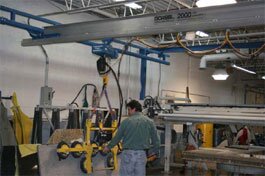
Monorails are a continuous run of fixed, overhead track on which trolleys travel while carrying loads.

Used for ergonomic reasons to help workers perform tasks with less risk of injury, workstation cranes handle loads weighing up to 4,000 pounds.
For materials that are too bulky or heavy to move through a process or facility with lift trucks or fixed, floor-mounted conveyors monorails and workstation cranes move and position loads. They maximize the vertical space in a facility by transporting loads overhead.
Their travel is directed by an operator, either manually or with a wired pendant station or wireless controls. These direct their horizontal, vertical or lateral load movements.
Monorails and workstation cranes are typically used to support manufacturing activities. Monorails typically transport loads from one process to the next. Workstation cranes are usually dedicated to a specific location to support a load during a specific step.
Monorail systems and workstation cranes come in a variety of styles and are used with a number of attachments to facilitate load lift, including:
Monorail systems and workstation cranes are used in a variety of areas to support processing and handling throughout a facility:
Monorail systems and workstation cranes provide a variety of benefits:
Monorail systems and workstation cranes assist in the lifting, positioning and movement of large, heavy loads throughout a facility in a variety of industries, including:
Copyright MHI © 2023 | All Rights Reserved